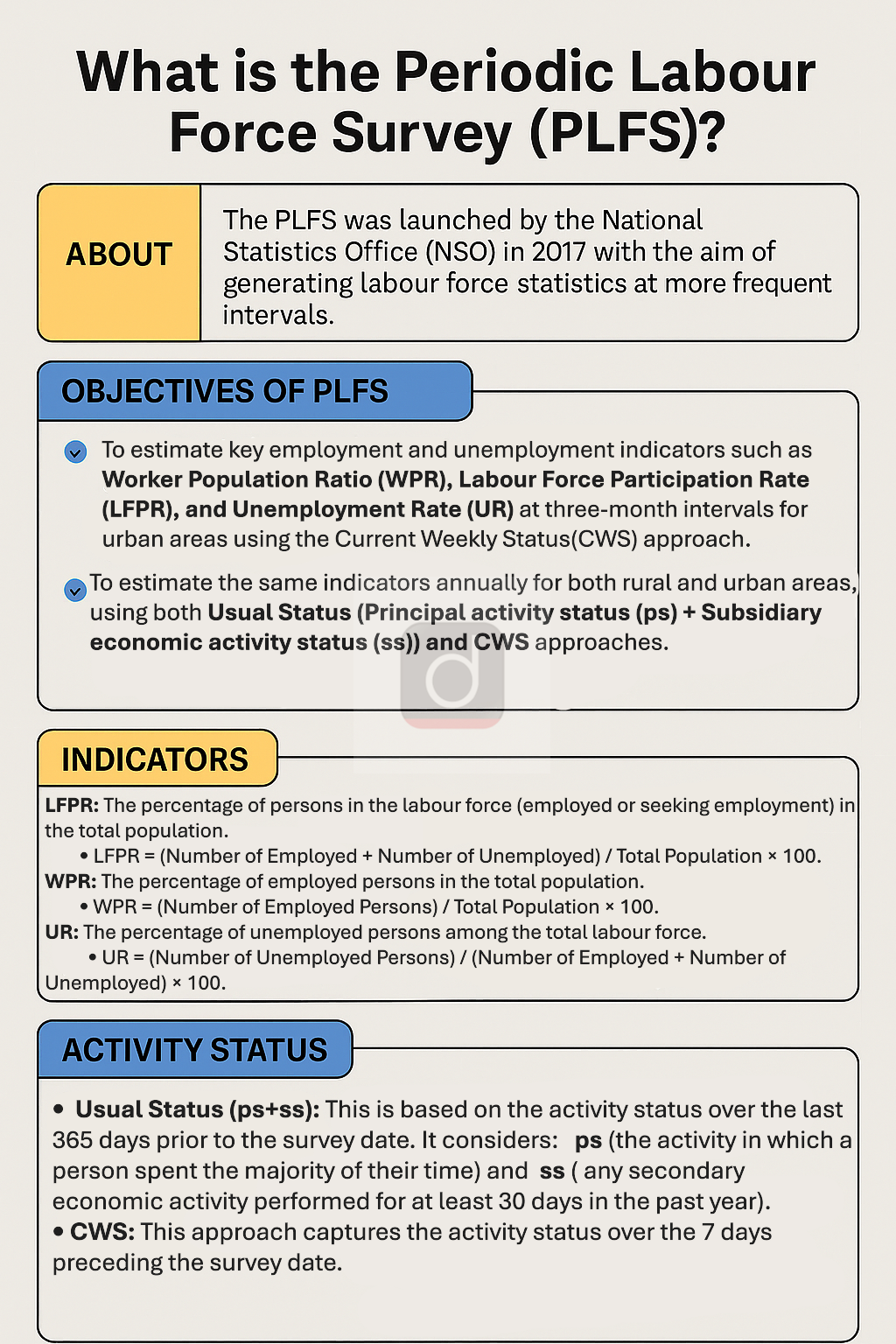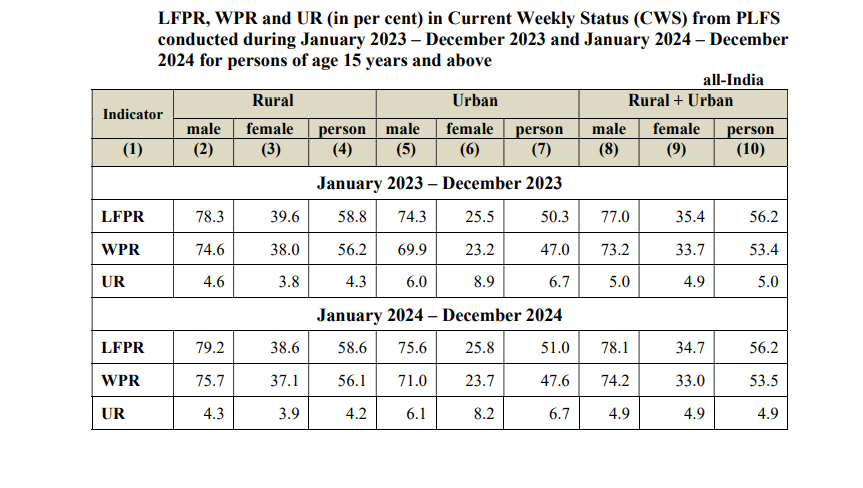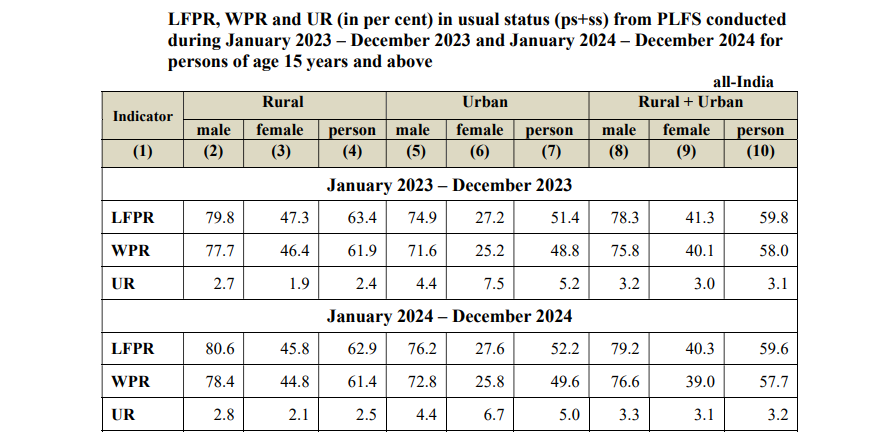Indian Economy
Periodic Labour Force Survey 2024
- 12 Apr 2025
- 8 min read
For Prelims: Periodic Labour Force Survey, International Labour Organization, SMILE, Rozgar Mela, Future Skills Prime
For Mains: Labour reforms and employment trends in India, Urban vs rural employment dynamics, Gender disparities in India’s labour force
Why in News?
The Ministry of Statistics and Programme Implementation (MoSPI) released the Periodic Labour Force Survey (PLFS) 2024. This data provides crucial insights into India’s evolving labour market dynamics across both rural and urban sectors.
What are the Key Findings of the PLFS 2024?
- Labour Force Indicators in Current Weekly Status(CWS):
- Labour Force Participation Rate (LFPR): Urban LFPR rose for males (74.3% to 75.6%) and slightly for females (25.5% to 25.8%), raising overall urban LFPR to 51.0%. All-India LFPR remained stable at 56.2%.
- Worker Population Ratio (WPR): Urban WPR rose slightly from 47.0% to 47.6% and all-India WPR was nearly unchanged at 53.5%.
- Unemployment Rate (UR): Rural unemployment fell slightly to 4.2%. Urban male UR rose, female UR declined, keeping overall urban UR rate at 6.7%. All-India UR dipped from 5.0% to 4.9%.
- Labour Force Indicators in Principal and Subsidiary Status(PS+SS):
- LFPR: Remained largely stable nationally, with a slight decline from 59.8% to 59.6%.
- WPR: All-India WPR declined slightly from 58.0% to 57.7%, indicating a minor drop in employment.
- UR: All-India UR rose slightly from 3.1% to 3.2%, with trends varying across sectors.
What are the Concerns Regarding India’s Labour Force?
- Gender Gaps: Female LFPR remains much lower than male, with urban female unemployment at 8.2%. Only 3% of employed women aged over 25 years hold advanced degrees, revealing underutilization of educated women and a mismatch between skills and job opportunities.
- Stagnation in Employment: WPR and LFPR show minimal year-on-year change, indicating sluggish job creation.
- Employment growth is not proportional to economic growth, indicating jobless or low-quality job growth.
- Youth Unemployment: A large proportion of the unemployed workforce consists of youth, especially those with secondary or higher education. According to the International Labour Organization (ILO), global youth unemployment was 13.3% in 2023. In contrast, India’s youth unemployment rate stood at 10.2% in 2023–24.
- Low Productivity: According to the ILO, India has the 2nd-longest average workweek globally at 46.7 hours, with 51% working over 49 hours, just behind Bhutan.
- Despite this, India's labour productivity remains low, with a Gross Domestic Product (GDP) per working hour of just USD 8, placing it 133rd globally as of 2023.
- Rural Employment Dependence: A large portion of the rural workforce remains engaged in low-productivity or subsistence work, raising concerns about underemployment and the prevalence of informal, insecure jobs over quality, skill-intensive employment.
What are India's Initiatives Related to Employment?
- Support for Marginalised Individuals for Livelihood and Enterprise (SMILE)
- PM-DAKSH (Pradhan Mantri Dakshta Aur Kushalta Sampann Hitgrahi)
- Mahatma Gandhi National Rural Employment Guarantee Act (MGNREGA)
- Pradhan Mantri Kaushal Vikas Yojana (PMKVY)
- Start Up India Scheme
- Rozgar Mela
- Indira Gandhi Urban Employment Guarantee Scheme- Rajasthan.
What Can Be Done to Improve India’s Labour Force?
- Bridge the Skill-Industry Mismatch: Promote outcome-based skilling through National Skill Development Corporation (NSDC) partnerships with private players.
- Integrate the Future Skills Prime ecosystem to equip youth with Industry 4.0 skills like Artificial Intelligence, data analytics, and cybersecurity.
- Drive Formalization with Inclusivity: Institutionalize ‘one-nation, one-registration’ for unorganized workers using e-Shram, Aadhaar and Unified Payments Interface (UPI) synergy.
- Facilitate micro-credit access and digital onboarding of MSMEs through schemes like PM Vishwakarma and Udyam Portal.
- Institutionalize Urban Employment and Mobility: Scale urban wage employment models based on Kerala’s Ayyankali Urban Employment Scheme (guarantee 100 days of wage employment per year to urban households with adults willing to do unskilled manual work).
- Create labour mobility corridors with housing, and insurance support for interstate migrant workers.
- Leverage Climate Transition for Job Creation: Channel investments into green sectors (solar, EVs, waste-to-energy) to generate employment with environmental dividends.
- Embed just transition principles to reskill workers from high-carbon sectors.
- Design Gendered Labour Reforms: States should pilot Women Workforce Participation Indices to map district-level constraints (e.g., transport, care work, patriarchal norms) and design targeted interventions.
- Link Corporate Social Responsibility spending mandates with support for women's skilling, mentoring, and return-to-work programs.
- Incentivize Employers: Offer Employment-Linked Incentive Schemes (ELI) where tax relief is proportionate to new formal jobs created.
- Provide fiscal benefits for companies adopting inclusive hiring practices (women, PwDs, elderly, and transgender persons).
|
Drishti Mains Question: Despite high economic growth, India continues to face challenges of jobless growth and youth unemployment. Discuss |
UPSC Civil Services Examination, Previous Year Questions (PYQs)
Prelims
Q. Increase in absolute and per capita real GNP do not connote a higher level of economic development, if(2018)
(a) industrial output fails to keep pace with agricultural output.
(b) agricultural output fails to keep pace with industrial output.
(c) poverty and unemployment increase.
(d) imports grow faster than exports.
Ans: (c)
Q. Disguised unemployment generally means (2013)
(a) large number of people remain unemployed
(b) alternative employment is not available
(c) marginal productivity of labour is zero
(d) productivity of workers is low
Ans: (c)
Mains
Q. Most of the unemployment in India is structural in nature. Examine the methodology adopted to compute unemployment in the country and suggest improvements. (2023)
Q.“Success of ‘Make in India’ program depends on the success of ‘Skill India’ programme and radical labour reforms.” Discuss with logical arguments. (2015)
Q. “While we flaunt India’s demographic dividend, we ignore the dropping rates of employability.” What are we missing while doing so? Where will the jobs that India desperately needs come from? Explain. (2014)







